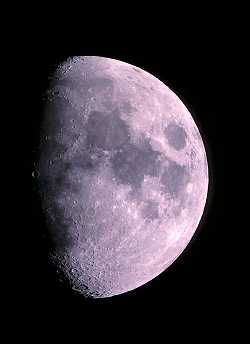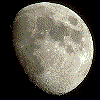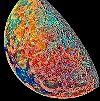
Taken with a 45cm f/5.4 Newtonian
Copyright © 1997 Gordon Garradd

Taken with a 45cm f/5.4 Newtonian Copyright © 1997 Gordon Garradd |
The Moon |

|
Michael Oates made this photographs
from Prestwich (Manchester) on March 15, 1989 at 22:20 UT. The lens was
mounted on a tripod with a small drive. The exposure was made with the
aid of a black piece of card held over the lens. Once the vibrations caused
by the shutter ceased, he moved away the card for several seconds. The
lens was a 800 mm telephoto plus two 2x teleconverters, giving an effective
focal length of 3200 at f64.
The first photo, taken with a 5 sec. exposure and Kodak Kodachrome 25 film, won the MAS Photographic Competition of April 1995. This digital version does not realy show just how sharp the image realy is. The second one, taken with a 2 sec. exposure and Kodak Tec Pan 2415 film, shows the Apennine Mountains and Alpine Valley. Visit Michael Oates' page. |

|
These false-color images of the Moon were taken
through three spectral filters by Galileo's
imaging system. The first one was constructed from a series of 53 images
taken as the spacecraft flew over the northern regions of the Moon on December
7, 1992. The part of the Moom visible from Earth is on the left side in
this view. Bright pinkish areas are highlands materials, such as those
surrounding the oval lava-filled Crisium impact basin toward
the bottom of the picture. Blue to orange indicate lava flows. To the left
of Crisium, the dark blue Mare Tranquillitatis is richer
in titanium than the green and orange maria above it.
The other mosaic was composed from 15 images taken on December 8, 1992, from 425,000 km. Mare Tranquillitatis is on the right (blue). Mare Serenitatis lies on the upper left of Mare Tranquillitatis. Blue and orange areas covering much of the left side of this view represent lava flows in Oceanus Procellarum. The small purple areas near the center are pyroclastic deposits formed by explosive volcanic eruptions. |
These four images show geological maps of the northern hemisphere of the Moon obtained from the data acquired by the Galileo spacecraft's Near-Infrared Mapping Spectrometer (NIMS) during December 1992 flyby: